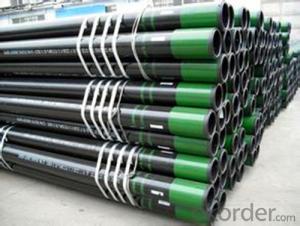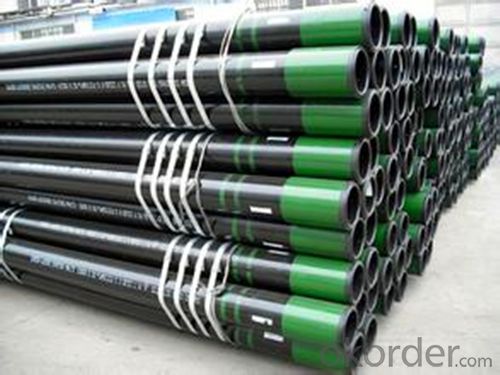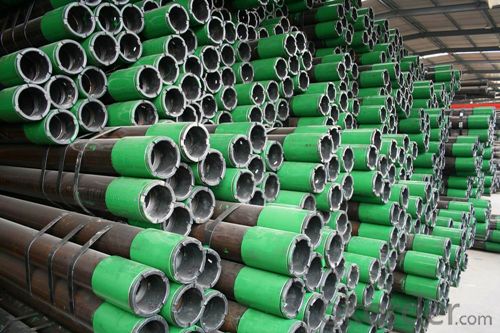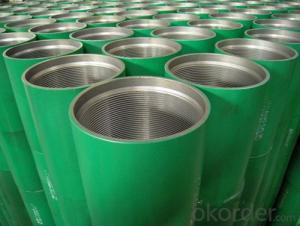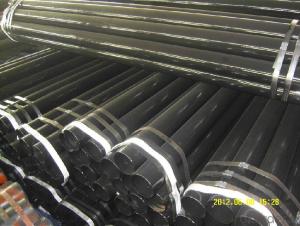Casing Pipe of Grade K55 with API Standard
- Loading Port:
- Qingdao
- Payment Terms:
- TT OR LC
- Min Order Qty:
- 20 m.t.
- Supply Capability:
- 2000 m.t./month
OKorder Service Pledge
OKorder Financial Service
You Might Also Like
1. Structure of Casing Pipe of Grade K55 Description
API 5CT Steel Pipe, K55 Oil/Petroleum Casing Pipe.
1) Grade: K55
2) Size: 4 1/2", 5", 5 1/2", 6 5/8", 7", 7 5/8", 9 5/8", 10 3/4", 13 3/8", 16", 18 5/8", 20"
3) Wall thickness: 6.35 - 12.70 mm
4) Thread type: STC, LTC, BTC
5) Length: R1,R2,R3
6) All our casings accord with API 5CT standard.
2. Main Features of Casing Pipe of Grade K55
1) Advanced test for quality
2) MTC, COC provided
3) Supervision is welcome
3. Casing Pipe of Grade K55 Images
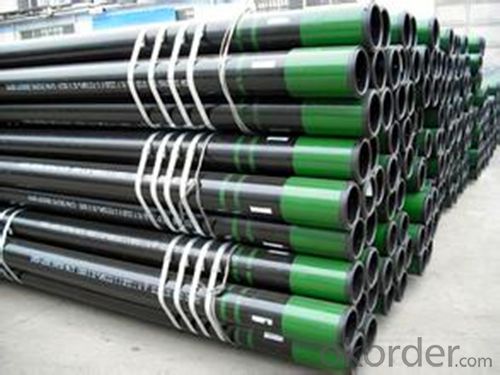

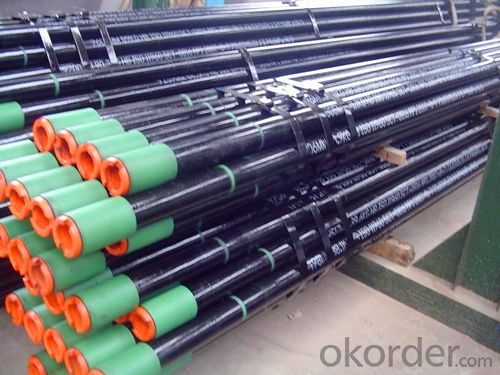
4. Casing Pipe of Grade K55 Specification
Size Destination | Weight Destination | Outside Diameter | Wall Thickness | Type of End Finish | ||||||
Grade | ||||||||||
in | mm | in | mm | J55 | L80 | N80 | C90 | P110 | ||
4 1/2 | 9.50 | 4.500 | 114.3 | 0.205 | 5.21 | PS | - | - | - | - |
10.50 | 0.224 | 5.69 | PSB | - | - | - | - | |||
11.60 | 0.250 | 6.35 | PSLB | PLB | PLB | PLB | PLB | |||
13.50 | 0.290 | 7.37 | - | PLB | PLB | PLB | PLB | |||
15.10 | 0.337 | 9.56 | - | - | - | - | PLB | |||
5 | 11.50 | 5.00 | 127.00 | 0.220 | 5.59 | PS | - | - | - | - |
13.00 | 0.253 | 6.43 | PSLB | - | - | - | - | |||
15.00 | 0.296 | 7.52 | PSLB | PLB | PLB | PLBE | PLB | |||
18.00 | 0.362 | 9.19 | - | PLB | PLB | PLBE | PLB | |||
21.40 | 0.437 | 11.10 | - | PLB | PLB | PLB | PLB | |||
23.20 | 0.478 | 12.14 | - | PLB | ||||||
24.10 | 0.500 | 12.70 | - | PLB | ||||||
5 1/2 | 14.00 | 5.500 | 139.7 | 0.244 | 6.20 | PS | - | - | - | - |
15.50 | 0.275 | 6.98 | PSLB | - | - | - | - | |||
17.00 | 0.304 | 7.72 | PSLB | PLB | PLB | PLBE | PLB | |||
20.00 | 0.361 | 9.17 | - | PLB | PLB | PLBE | PLB | |||
23.00 | 0.415 | 10.54 | - | PLB | PLB | PLBE | PLB | |||
6 5/8 | 20.00 | 6.625 | 168.28 | 0.288 | 7.32 | PSLB | - | - | - | - |
24.00 | 0.352 | 8.94 | PSLB | PLB | PLB | PLBE | PLB | |||
28.00 | 0.417 | 10.59 | - | PLB | PLB | PLBE | PLB | |||
32.00 | 0.475 | 12.06 | - | PLB | PLB | PLBE | PLB | |||
7 | 17.00 | 7.00 | 177.80 | 0.231 | 5.87 | - | - | - | - | - |
20.00 | 0.272 | 6.91 | PS | - | - | - | - | |||
23.00 | 0.317 | 8.05 | PSLB | PLB | PLB | PLBE | - | |||
26.00 | 0.362 | 9.19 | PSLB | PLB | PLB | PLBE | PLB | |||
29.00 | 0.408 | 10.36 | - | PLB | PLB | PLBE | PLB | |||
32.00 | 0.453 | 11.51 | - | PLB | PLB | PLBE | PLB | |||
35.00 | 0.498 | 12.65 | - | PLB | PLB | PLBE | PLB | |||
38.00 | 0.540 | 13.72 | - | PLB | PLB | PLBE | PLB | |||
7 5/8 | 24.00 | 7.625 | 193.68 | 0.300 | 7.62 | - | - | - | - | - |
26.40 | 0.328 | 8.33 | PSLB | PLB | PLB | PLBE | PLB | |||
29.70 | 0.375 | 9.52 | - | PLB | PLB | PLBE | PLB | |||
33.70 | 0.430 | 10.92 | - | PLB | PLB | PLBE | PLB | |||
39.00 | 0.500 | 12.70 | - | PLB | PLB | PLBE | PLB | |||
42.80 | 0.562 | 14.27 | - | PLB | PLB | PLB | PLB | |||
45.30 | 0.595 | 15.11 | - | PLB | PLB | PLB | PLB | |||
47.10 | 0.625 | 15.88 | - | PLB | PLB | PLB | PLB | |||
8 5/8 | 24.00 | 8.625 | 219.08 | 0.264 | 6.71 | PS | - | - | - | - |
28.00 | 0.304 | 7.72 | - | - | - | - | - | |||
32.00 | 0.352 | 8.94 | PSLB | - | - | - | - | |||
36.00 | 0.400 | 10.16 | PSLB | PLB | PLB | PLBE | PLB | |||
40.00 | 0.450 | 11.43 | - | PLB | PLB | PLBE | PLB | |||
44.00 | 0.500 | 12.70 | - | PLB | PLB | PLBE | PLB | |||
49.00 | 0.557 | 14.15 | - | PLB | PLB | PLBE | PLB | |||
9 5/8 | 32.30 | 9.625 | 244.48 | 0.312 | 7.92 | - | - | - | - | - |
36.00 | 0.352 | 8.94 | PSLB | - | - | - | - | |||
40.00 | 0.395 | 10.03 | PSLB | PLB | PLB | PLBE | - | |||
43.50 | 0.435 | 11.05 | - | PLB | PLB | PLBE | PLB | |||
47.00 | 0.472 | 11.99 | - | PLB | PLB | PLBE | PLB | |||
53.50 | 0.545 | 13.84 | - | PLB | PLB | PLBE | PLB | |||
58.40 | 0.595 | 15.11 | - | PLB | PLB | PLB | PLB | |||
10 3/4 | 32.75 | 10.75 | 273.05 | 0.279 | 7.09 | - | - | - | - | - |
40.50 | 0.350 | 8.89 | PSB | - | - | - | - | |||
15.50 | 0.400 | 10.16 | PSB | - | - | - | - | |||
51.00 | 0.450 | 11.43 | PSB | PSB | PSB | PSBE | PSB | |||
55.50 | 0.495 | 12.57 | - | PSB | PSB | PSBE | PSB | |||
60.70 | 0.545 | 13.84 | - | - | - | PSBE | PSB | |||
65.70 | 0.595 | 15.11 | - | - | - | PSB | PSB | |||
13 3/8 | 48.00 | 13.375 | 339.73 | 0.330 | 8.38 | - | - | - | - | - |
54.50 | 0.380 | 9.65 | PSB | - | - | - | - | |||
61.00 | 0.430 | 10.92 | PSB | - | - | - | - | |||
68.00 | 0.480 | 12.19 | PSB | PSB | PSB | PSB | PSB | |||
72.00 | 0.514 | 13.06 | - | PSB | PSB | PSB | PSB | |||
16 | 65.00 | 16 | 406.40 | 0.375 | 9.53 | - | - | - | - | - |
75.00 | 0.438 | 11.13 | PSB | - | - | - | - | |||
84.00 | 0.495 | 12.57 | PSB | - | - | - | - | |||
109.00 | 0.656 | 16.66 | P | P | P | - | P | |||
18 5/8 | 87.50 | 18.625 | 473.08 | 0.435 | 11.05 | PSB | - | - | - | - |
20 | 94.00 | 20 | 508.00 | 0.438 | 11.13 | PSLB | - | - | - | - |
106.50 | 0.500 | 12.70 | PSLB | - | - | - | - | |||
133.00 | 0.635 | 16.13 | PSLB | - | - | - | - | |||
5. FAQ of Casing Pipe of Grade K55
We have organized several common questions for our clients,may help you sincerely:
①How about your company?
One of the leading manufacturers and suppliers specializing in steel pipe products in China, mainly offering four series steel pipes including welded steel pipe (ERW, SSAW, LSAW and square and rectangle pipe), seamless steel pipe, hot dipped galvanized steel pipe and steel pipe with 3 layer polythene coating. We can provide customers different specification standards e.g. ASTM A53, ASTM A106, BS1387, API 5L, API 5CT, ISO3183 and etc. Our scope of supplying covers from 1/2" to 48" for the outside diameter of welded pipes, and 1/8" to 20" for the seamless pipes.
Other than steel pipes we are also capable of supplying a wide variety of pipeline accessories, steel pipe fittings; valves etc. consists of our one-stop sales. The integrated sales & service ensures customers with various demands an easier access for purchasing management.
②How to guarantee the quality of the products?
We have established the international advanced quality management system,every link from raw material to final product we have strict quality test;We resolutely put an end to unqualified products flowing into the market. At the same time, we will provide necessary follow-up service assurance.
③How long can we receive the product after purchase?
In the purchase of product within three working days, We will arrange the factory delivery as soon as possible.
- Q: How are steel pipes used in the construction of telecommunications towers?
- Steel pipes are commonly used in the construction of telecommunications towers as they provide the necessary structural support and stability. These pipes are used for the tower's main framework, ensuring its durability and ability to withstand various environmental conditions. Additionally, steel pipes are also used for cable management, allowing for the safe and efficient installation of telecommunications equipment and cables.
- Q: Are steel pipes resistant to ultraviolet (UV) radiation?
- Steel pipes are not inherently resistant to ultraviolet (UV) radiation. UV radiation can cause degradation and discoloration of certain materials, including steel. However, the extent of the damage depends on various factors such as the type of steel, the duration and intensity of exposure to UV radiation, and the presence of protective coatings or finishes on the steel pipes. In general, uncoated steel pipes are more susceptible to UV radiation damage compared to pipes that have been treated with protective coatings or finishes. These coatings, such as epoxy or polyethylene, provide a barrier against UV radiation and help to prevent the degradation and discoloration of the steel. Therefore, it is important to consider the specific application and environment when choosing steel pipes and implementing appropriate protective measures to ensure their longevity and performance.
- Q: What are the different sizes of steel pipes available?
- Steel pipes are available in a wide range of sizes, varying from small diameter pipes used for plumbing applications to large diameter pipes used for industrial purposes. The sizes typically range from 1/8 inch to 72 inches in diameter, with various wall thickness options.
- Q: What is the difference between internal lining and external coating of steel pipes?
- The difference between internal lining and external coating of steel pipes lies in their respective purposes and locations. Internal lining refers to the material applied inside the steel pipes to protect the inner surface from corrosion, abrasion, or other forms of damage. It acts as a barrier between the transported fluids or substances and the steel pipe, preventing them from coming into direct contact and causing deterioration. The internal lining is typically made of materials like epoxy, polyethylene, or cement mortar, depending on the specific requirements and the nature of the transported substances. It ensures the longevity and integrity of the steel pipe by reducing the chances of internal corrosion and minimizing the risk of contamination. External coating, on the other hand, is applied to the outer surface of the steel pipes. Its main purpose is to provide protection against external factors such as weathering, soil corrosion, and mechanical damage. The external coating acts as a shield, safeguarding the steel pipe from environmental conditions like moisture, UV radiation, chemicals, and physical impact. Common materials used for external coatings include fusion-bonded epoxy, polyethylene, polypropylene, or bitumen. The choice of coating depends on factors like the exposure conditions, temperature, and the type of soil or surroundings the steel pipe will encounter. In summary, while internal lining protects the inner surface of steel pipes from corrosion and damage caused by transported substances, external coating acts as a barrier against external elements and physical stresses. Both internal lining and external coating play vital roles in ensuring the durability and reliability of steel pipes in various applications, such as oil and gas pipelines, water supply systems, or industrial processes.
- Q: What are the common standards and specifications for steel pipes?
- The common standards and specifications for steel pipes include ASTM A53, ASTM A106, API 5L, and ISO 3183. These standards outline the requirements for the manufacturing, dimensions, and mechanical properties of steel pipes used in various industries such as oil and gas, construction, and transportation. Additionally, specific applications may have their own standards and specifications that need to be met for quality and safety purposes.
- Q: What are the advantages of using steel pipes in plumbing systems?
- There are several advantages of using steel pipes in plumbing systems. Firstly, steel pipes are highly durable and have a long lifespan, making them a reliable choice for plumbing installations. They are resistant to corrosion, rust, and other forms of damage, ensuring the integrity of the plumbing system over time. Additionally, steel pipes have a high tensile strength, allowing them to withstand high pressure and heavy loads without deformation or leakage. They also have excellent heat resistance, making them suitable for hot water and steam applications. Lastly, steel pipes offer a smooth inner surface, minimizing friction and maintaining a consistent flow rate, which is crucial for efficient water distribution and drainage in plumbing systems.
- Q: How long do steel pipes last?
- The lifespan of steel pipes can vary depending on several factors, including the quality of the steel used, the environment in which they are installed, and the maintenance and care given to them. Generally, steel pipes are known for their durability and longevity. With proper installation and regular maintenance, steel pipes can last for several decades, often exceeding 50 years. However, it is important to note that external factors such as corrosion, exposure to extreme temperatures, and chemical reactions can significantly affect their lifespan. Regular inspections, timely repairs, and protective coatings can help extend the life of steel pipes, ensuring their reliability and functionality for many years.
- Q: Can steel pipes be used for oil transportation?
- Yes, steel pipes are commonly used for oil transportation due to their high strength, durability, and resistance to corrosion.
- Q: How are steel pipes used in bridge construction?
- Steel pipes are commonly used in bridge construction for various purposes. They are often used as piles to provide structural support to the bridge foundation, ensuring stability against soil movement and water pressure. Additionally, steel pipes are used as structural components in the bridge's superstructure, such as for trusses and beams, due to their high strength and durability. Steel pipes also play a crucial role in carrying utilities, such as water and gas pipelines, across the bridge. Overall, steel pipes are an essential element in bridge construction, providing strength, stability, and functionality to the structure.
- Q: How are steel pipes used in the construction of power transmission lines?
- Steel pipes are commonly used in the construction of power transmission lines due to their exceptional strength, durability, and versatility. These pipes serve various purposes throughout the project, contributing to the overall efficiency and reliability of the power transmission system. One primary application of steel pipes in power transmission line construction is for the installation of transmission towers. These pipes are used as structural components to support the transmission lines and maintain their alignment. The high strength of steel ensures that the towers can withstand the weight of the transmission lines, as well as external forces such as wind and ice loads. Moreover, steel pipes offer excellent resistance against corrosion, which is crucial for the longevity of the transmission tower structures. In addition to tower construction, steel pipes are also utilized for the underground transmission lines. These pipes act as conduits for the cables, protecting them from external elements and potential damage. Steel pipes are particularly advantageous in this application due to their ability to resist soil movement, withstand high pressure, and provide a secure pathway for the power cables. Furthermore, the durability of steel ensures the integrity and longevity of the underground transmission lines, reducing maintenance requirements and enhancing the overall reliability of the power transmission system. Furthermore, steel pipes are used for the construction of foundations and anchors for transmission towers. These pipes are driven deep into the ground to provide stability and support to the towers. The inherent strength and rigidity of steel pipes make them ideal for this purpose, as they can withstand the heavy loads and ensure the stability of the transmission towers even in adverse weather conditions. Overall, steel pipes play a crucial role in the construction of power transmission lines by providing structural support, protecting cables, and ensuring the overall reliability and efficiency of the transmission system. Their exceptional strength, durability, and resistance to corrosion make steel pipes an ideal choice for power transmission line construction projects.
Send your message to us
Casing Pipe of Grade K55 with API Standard
- Loading Port:
- Qingdao
- Payment Terms:
- TT OR LC
- Min Order Qty:
- 20 m.t.
- Supply Capability:
- 2000 m.t./month
OKorder Service Pledge
OKorder Financial Service
Similar products
Hot products
Hot Searches
Related keywords
